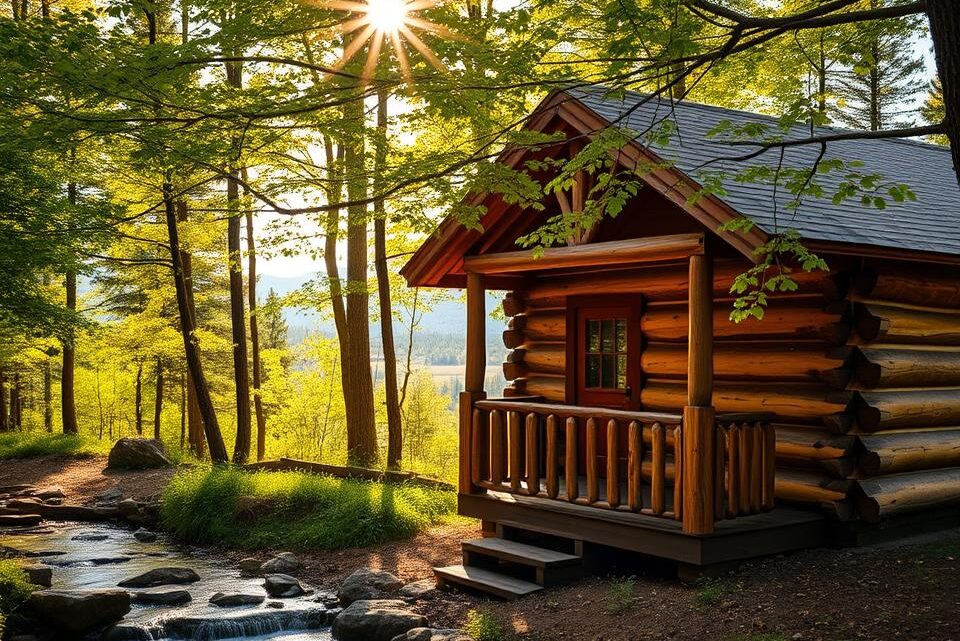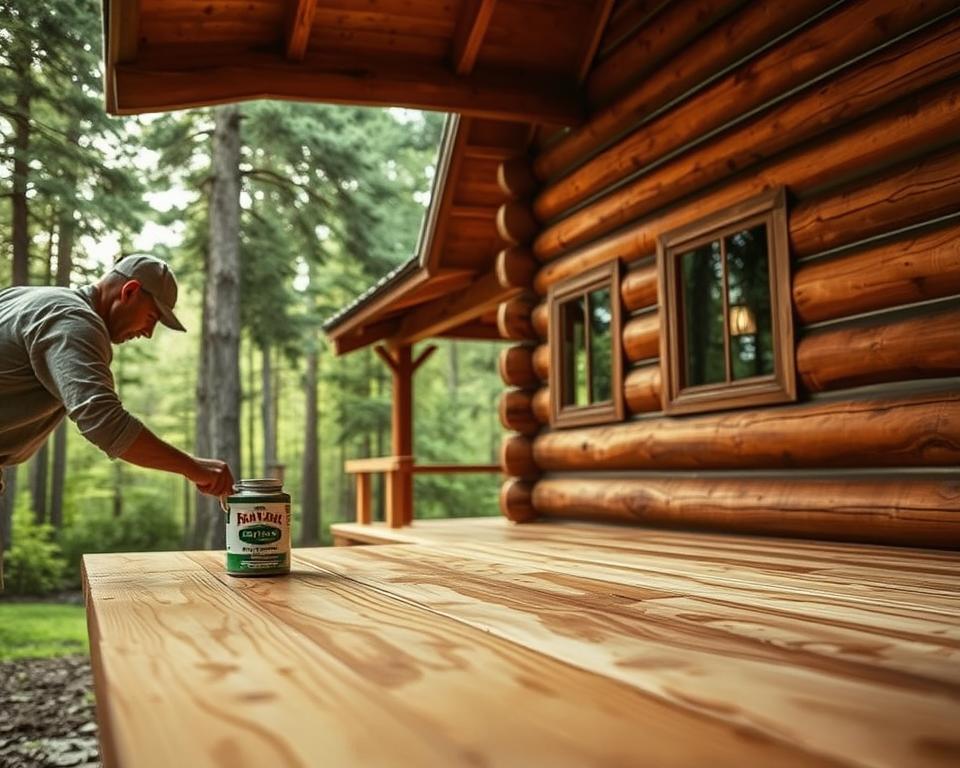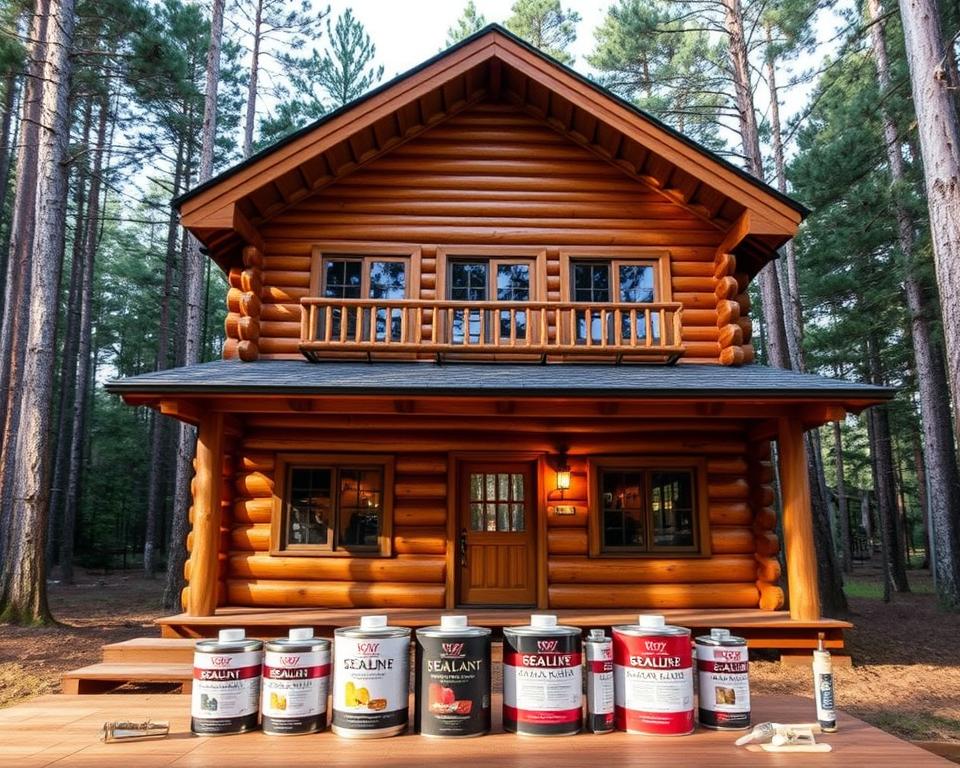Do Log Cabins Get Damp? – Guide to Prevention & Care

Wooden structures like log cabins are cherished for their rustic charm and natural beauty, but they face significant challenges with log cabin dampness. The British climate presents unique moisture prevention challenges that can impact wooden structure care. Understanding these risks is crucial for maintaining a healthy, long-lasting log cabin.
Moisture can silently damage log cabins, compromising their structural integrity and aesthetic appeal. Homeowners must be proactive in identifying and addressing potential dampness issues before they escalate into costly repairs. Wooden structures require specialised attention to protect against environmental moisture threats.
This comprehensive guide explores the intricacies of log cabin moisture management, offering practical insights and strategies to keep your wooden retreat dry, comfortable, and structurally sound.
Inhaltsverzeichnis
Key Takeaways
- Log cabins are susceptible to moisture-related challenges
- Regular inspection prevents long-term structural damage
- Proper ventilation is critical for moisture control
- British climate demands specific wooden structure care techniques
- Professional treatments can significantly enhance cabin protection
Understanding Moisture Challenges in Log Cabins
Log cabins in the United Kingdom face unique wooden structure dampness challenges due to the region’s distinctive climate. Understanding these moisture-related issues is crucial for maintaining the integrity and longevity of your wooden home.
Types of Dampness in Wooden Structures
Wooden structures are particularly vulnerable to various moisture-related problems. The primary types of dampness include:
- Rising Damp: Moisture climbing from the ground through porous materials
- Penetrating Damp: Water entering through structural weaknesses
- Condensation: Moisture forming from temperature differences
Common Areas Affected by Moisture
Certain moisture-prone areas in log cabins require special attention:
| Location | Moisture Risk | Potential Damage |
|---|---|---|
| Foundation | High | Structural weakening |
| Roof Edges | Medium | Wood rot and decay |
| Window Frames | High | Mould growth |
Impact of British Climate on Log Homes
The UK climate effects significantly influence log cabin moisture challenges. Frequent rainfall, high humidity, and temperature fluctuations create an environment where wooden structures are constantly at risk of moisture absorption.
Recognising these challenges is the first step in protecting your log cabin from potential damage caused by persistent dampness.
Do Log Cabins Get Damp?

Log cabins possess a natural vulnerability to wood dampness factors that can compromise their structural integrity and comfort. Understanding log cabin moisture susceptibility is crucial for homeowners seeking to protect their wooden retreats from potential water-related damage.
Wooden structures inherently absorb moisture from their surrounding environment. Several key factors contribute to log cabin dampness:
- Proximity to ground and water sources
- Local climate conditions
- Quality of initial wood treatment
- Construction techniques
- Maintenance practices
The porous nature of wood makes log cabins particularly sensitive to moisture penetration. Untreated or poorly sealed wood can quickly become a breeding ground for mould, rot, and structural weakness. British weather, with its frequent rainfall and high humidity, presents significant challenges for log cabin owners.
Wood dampness factors are not insurmountable challenges. Proactive measures can significantly reduce moisture-related risks:
- Regular inspection of wooden surfaces
- Appropriate waterproofing treatments
- Ensuring proper ventilation
- Maintaining optimal ground clearance
- Implementing effective drainage systems
Professional log cabin builders understand these moisture dynamics and employ specialised techniques to minimise log cabin moisture susceptibility. With careful planning and consistent maintenance, homeowners can enjoy a dry, comfortable, and long-lasting wooden sanctuary.
Signs of Dampness in Your Log Cabin
Detecting moisture in your log cabin is crucial for maintaining its structural integrity and preventing long-term damage. Damp detection requires a keen eye and understanding of potential moisture signs that can compromise your wooden sanctuary.

Moisture challenges can develop silently, making early identification critical for log cabin owners. Recognising these signs will help you protect your investment and ensure a healthy living environment.
Visual Indicators of Moisture Problems
Spotting damp-related issues early can save significant repair costs. Look out for these critical moisture signs:
- Dark or discoloured wood patches
- Visible mould growth
- Soft or rotting wooden surfaces
- Warping or swelling of wooden structures
- Peeling paint or finish
Hidden Moisture Warning Signs
Not all humidity measurement indicators are immediately visible. Some subtle signs include:
- Musty or damp odours
- Unexplained increase in heating costs
- Condensation on windows and walls
- Unexplained allergic reactions
Using Moisture Meters Effectively
Invest in a professional moisture meter to conduct precise humidity measurement in your log cabin. These devices provide critical insights into potential damp problems before they become visible.
| Moisture Meter Type | Accuracy | Best Use |
|---|---|---|
| Pin-type Meter | High | Precise wood moisture readings |
| Pinless Meter | Medium | Surface scanning |
| Infrared Thermal Camera | High | Detecting hidden moisture zones |
Regular monitoring and proactive damp detection will help preserve your log cabin’s structural health and aesthetic appeal.
Essential Waterproofing Methods for Log Cabins

Protecting your log cabin from moisture damage requires strategic log cabin waterproofing approaches. Wooden structures are particularly vulnerable to water penetration, making moisture barrier techniques crucial for long-term preservation.
Effective waterproofing involves multiple layers of protection. The primary strategies include:
- Applying water-repellent sealants
- Creating proper drainage systems
- Installing protective roof overhangs
- Sealing potential entry points
Understanding the critical areas of vulnerability helps homeowners implement targeted moisture barrier techniques. Wood joints, window frames, and foundation interfaces are prime locations requiring special attention.
| Waterproofing Method | Effectiveness | Recommended Frequency |
|---|---|---|
| Exterior Wood Sealant | High | Every 2-3 years |
| Silicone-Based Treatments | Medium-High | Every 3-4 years |
| Breathable Waterproof Membranes | High | Every 5 years |
Professional application ensures maximum protection against moisture infiltration. Regular inspections and proactive maintenance can significantly extend your log cabin’s lifespan and structural integrity.
Proper Ventilation Systems and Their Importance
Log cabin ventilation is a critical aspect of maintaining a healthy and comfortable living environment. Effective air circulation plays a crucial role in preventing moisture buildup and protecting the structural integrity of wooden structures.

Moisture control begins with understanding the unique challenges of log cabin environments. Poor ventilation can lead to significant problems, including wood rot, mould growth, and structural damage.
Natural Ventilation Strategies
Natural ventilation offers several benefits for log cabins:
- Utilises existing air currents
- Cost-effective solution
- Minimal energy consumption
- Promotes healthy indoor air quality
Mechanical Ventilation Options
For more controlled air circulation, mechanical ventilation systems provide precise humidity management:
- Exhaust fans in high-moisture areas
- Whole-house ventilation systems
- Dehumidifiers for targeted moisture control
Seasonal Ventilation Considerations
Each season demands a unique approach to log cabin ventilation. Winter requires careful humidity balance, while summer necessitates increased air movement to prevent stagnation.
Proper ventilation is not just about air movement—it’s about creating a balanced, healthy living environment.
Implementing a comprehensive ventilation strategy will protect your log cabin from moisture-related issues and ensure a comfortable, long-lasting living space.
Foundation and Ground Contact Solutions
Creating robust log cabin foundations is crucial for long-term moisture protection. Proper ground moisture prevention starts with strategic planning and intelligent design choices that shield your wooden structure from potential water damage.
Log cabin foundations require careful consideration to minimise ground moisture risks. Effective strategies include:
- Elevating the cabin’s base above ground level
- Installing robust damp-proof courses
- Implementing comprehensive drainage systems
- Selecting appropriate foundation materials
Raising your log cabin’s foundation helps create a crucial barrier against ground moisture. Experts recommend a minimum elevation of 30-45 centimetres to prevent direct water contact. This simple technique significantly reduces potential dampness risks.
Drainage solutions play a critical role in ground moisture prevention. Consider these key approaches:
- Create gentle ground slopes away from the cabin
- Install perimeter drainage channels
- Use gravel or stone borders around foundation edges
- Ensure consistent ground water management
Proactive foundation design protects your log cabin’s structural integrity and prevents costly moisture-related repairs.
Protective Treatments and Sealants
Protecting your log cabin from moisture requires strategic wood protection techniques. Waterproof treatments are crucial for maintaining the structural integrity and aesthetic appeal of your wooden retreat. The right log cabin sealants can significantly extend the life of your cabin, preventing water damage and decay.

Selecting the most effective waterproof treatments involves understanding the unique characteristics of your log cabin’s wood and environmental conditions. Different wood types and exposure levels demand specific protective approaches.
Best Waterproof Coatings
Top-tier log cabin sealants offer comprehensive protection against moisture intrusion. The most recommended options include:
- Silicone-based penetrating sealers
- Water-repellent wood preservatives
- Acrylic-based exterior wood treatments
- Polyurethane protective coatings
Application Techniques
Proper application of wood protection treatments is essential for maximum effectiveness. Key steps include:
- Thoroughly clean and dry the wood surface
- Sand any rough areas to ensure smooth application
- Apply sealant using professional-grade brushes or sprayers
- Ensure complete coverage with multiple thin layers
Maintenance Schedule
Regular maintenance of waterproof treatments keeps your log cabin resilient. Experts recommend reapplying protective coatings every 2-3 years, depending on exposure and wear.
Professional assessment can help determine the optimal maintenance frequency for your specific log cabin environment.
Regular Maintenance and Inspection Routines
Effective log cabin upkeep requires a systematic approach to moisture check routines. Protecting your wooden sanctuary demands regular attention and proactive care. Homeowners can transform maintenance from a daunting task into an enjoyable ritual that preserves their cherished retreat.
A comprehensive moisture check routine involves several critical steps:
- Inspect exterior wood surfaces quarterly for signs of water damage
- Check roof and guttering for potential water infiltration points
- Examine window and door seals for potential moisture penetration
- Monitor interior walls for subtle dampness indicators
Seasonal inspections play a crucial role in log cabin maintenance. During spring and autumn, conduct thorough examinations of your cabin’s structural integrity. Pay special attention to areas prone to moisture accumulation, such as foundations, roof edges, and lower wall sections.
Recommended maintenance tools for your log cabin upkeep include:
- Moisture metre
- Waterproof sealant
- Protective wood treatment
- Soft-bristled cleaning brush
By implementing a consistent moisture check routine, you’ll safeguard your log cabin against potential water damage, ensuring its longevity and aesthetic appeal for years to come.
Managing Indoor Humidity Levels
Maintaining optimal indoor moisture control is crucial for log cabin owners. Log cabin humidity can significantly impact the structural integrity and comfort of your wooden retreat. Understanding and managing humidity levels protects your investment and ensures a healthy living environment.
Wooden structures are particularly sensitive to moisture fluctuations. Proper dehumidification helps prevent potential damage and maintains the cabin’s longevity.
Ideal Humidity Range
For log cabins, the recommended indoor humidity range is between 40% and 60%. This sweet spot prevents:
- Wood warping
- Mould growth
- Structural degradation
- Pest infestations
Dehumidification Solutions
Effective indoor moisture control requires strategic approaches:
- Invest in quality dehumidifiers
- Use moisture-absorbing materials
- Implement proper ventilation systems
Seasonal Humidity Control
| Season | Humidity Challenge | Recommended Action |
|---|---|---|
| Winter | Low humidity | Use humidifiers sparingly |
| Summer | High humidity | Run dehumidifiers consistently |
| Autumn/Spring | Variable humidity | Monitor and adjust regularly |
Proactive humidity management protects your log cabin from moisture-related issues and ensures a comfortable living space throughout the year.
Addressing Existing Damp Problems
Discovering dampness in your log cabin can be distressing, but effective log cabin damp treatment is possible with the right approach. Moisture damage repair requires a systematic assessment of the affected areas to prevent further structural deterioration.
Start by identifying the primary sources of moisture. Key areas to inspect include:
- Roof and ceiling junctions
- Window and door frames
- Ground-level wooden surfaces
- Interior wall connections
When conducting moisture damage repair, prioritise these critical steps:
- Thorough Cleaning: Remove mould and mildew using specialised wood-safe cleaning solutions
- Drying Process: Use industrial dehumidifiers to extract excess moisture
- Structural Assessment: Check for wood rot and potential structural weaknesses
- Protective Treatment: Apply wood preservatives to prevent future log cabin damp treatment issues
Professional intervention might be necessary for extensive moisture damage. Timber specialists can provide detailed assessments and targeted repair strategies, ensuring your log cabin remains structurally sound and protected against future dampness.
Preventive Design Features for New Log Cabins
Creating a moisture-resistant log cabin requires strategic design considerations from the ground up. Damp-proof construction begins with intelligent architectural planning that protects wooden structures from environmental challenges.
Key preventive design features for moisture-resistant log cabin design include:
- Elevated foundation with proper drainage systems
- Overhanging roof designs extending at least 600mm beyond walls
- Breathable wall construction techniques
- Strategic window and door placement
Roof design plays a critical role in damp-proof construction. Steep-pitched roofs with substantial overhangs prevent water from directly contacting log walls. Architectural precision minimises potential moisture penetration points.
“Prevention is always more cost-effective than remediation in log cabin construction.” – Traditional British Carpentry Wisdom
Modern moisture-resistant materials offer additional protection. Innovative timber treatments, advanced sealants, and vapour-control layers create robust barriers against dampness. Selecting high-quality, naturally resistant timber species further enhances a log cabin’s resilience.
- Use pressure-treated timber
- Apply professional-grade water-resistant coatings
- Install efficient drainage channels
By integrating these preventive design features, homeowners can establish a robust defence against moisture intrusion, ensuring their log cabin remains dry, comfortable, and structurally sound for decades.
Conclusion
Protecting your log cabin from dampness is an essential skill for maintaining a healthy, comfortable wooden home. By understanding moisture challenges and implementing strategic prevention techniques, homeowners can create damp-free wooden homes that withstand the unpredictable British climate.
Log cabin moisture prevention requires a comprehensive approach. From proper foundation design and waterproofing treatments to robust ventilation systems and regular maintenance, each strategy plays a crucial role in protecting your timber structure. Investing time and effort in these preventative measures will significantly reduce the risk of moisture-related damage.
Ultimately, successful log cabin care is about proactive management. Regular inspections, timely treatments, and a deep understanding of wood’s natural properties will help you maintain a dry, resilient living space. With the right knowledge and commitment, your log cabin can remain a beautiful, moisture-resistant sanctuary for years to come.
Remember that every log cabin is unique, and local environmental conditions will influence your specific moisture management strategy. Seek professional advice when needed, and continue learning about the best practices for preserving your wooden retreat.
FAQ
How quickly can dampness damage a log cabin?
Dampness can cause significant damage if left unchecked. Typically, wooden structures can start showing signs of deterioration within 6-12 months of consistent moisture exposure. Timber can begin to rot, develop mould, and lose structural integrity, making early detection and prevention crucial for maintaining your log cabin’s longevity.
What is the most common cause of dampness in log cabins?
The most frequent cause of dampness is poor ventilation combined with inadequate waterproofing. In the British climate, condensation, ground moisture, and rainfall can quickly penetrate untreated wood, creating an environment ripe for moisture-related issues.
How often should I inspect my log cabin for moisture problems?
We recommend conducting a thorough inspection at least twice a year – ideally in spring and autumn. Pay special attention to areas prone to moisture, such as foundations, roof edges, window frames, and interior walls. Regular checks can help you catch and address potential damp issues before they become serious problems.
Can I use standard home dehumidifiers in my log cabin?
While standard dehumidifiers can help, it’s best to use specialised units designed for wooden structures. Look for dehumidifiers with moisture control settings specifically suitable for log cabins, which can maintain optimal humidity levels between 50-60% to prevent wood damage.
Are there specific seasons when dampness is more likely in log cabins?
Autumn and winter are typically the most challenging seasons for log cabin moisture control. The combination of cold external temperatures, high rainfall, and increased indoor heating creates perfect conditions for condensation and moisture buildup.
How effective are water-repellent treatments for log cabins?
Professional-grade water-repellent treatments can be extremely effective when applied correctly. They create a protective barrier that prevents moisture penetration while allowing the wood to breathe. However, these treatments require regular reapplication, typically every 2-3 years, to maintain their protective qualities.
What are the warning signs of serious moisture damage?
Key warning signs include visible mould growth, soft or spongy wood, musty odours, discolouration of wooden surfaces, peeling paint or sealant, and increased indoor humidity. If you notice these signs, it’s crucial to investigate and address the underlying moisture issues promptly.
Can proper ventilation completely prevent dampness?
While excellent ventilation significantly reduces moisture risks, it cannot completely eliminate all potential damp issues. It’s most effective when combined with other preventative measures like proper sealing, regular maintenance, and moisture-resistant treatments.
How much does professional damp-proofing cost for a log cabin?
Costs can vary widely depending on the cabin’s size and existing damage. Professional damp-proofing typically ranges from £500 to £3,000 for comprehensive treatment. However, investing in preventative measures is often far less expensive than repairing extensive moisture damage.
Are modern log cabins more resistant to dampness?
Contemporary log cabins benefit from advanced construction techniques and materials that offer improved moisture resistance. Modern designs incorporate better sealing methods, more effective water-resistant treatments, and enhanced ventilation systems compared to traditional log cabin construction.

